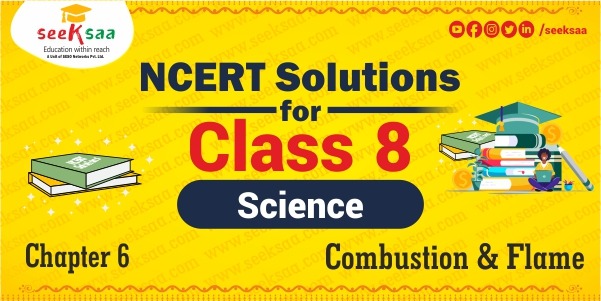| Section Name | Topic Name |
|---|---|
| 6 | Materials combustion and flame |
| 6.1 | What is Combustion? |
| 6.2 | How Do We Control Fire? |
| 6.3 | Types of Combustion |
| 6.4 | Flame |
| 6.5 | Structure of a Flame |
Q 1- List conditions under which combustion can take place.
Ans. There are three essential conditions of combustion:
(a) Presence of a combustible substance.
(b) Presence of oxygen, i.e., supporter of combustion.
(c) Attainment of ignition temperature.
Q 2- Fill in the blanks:
(a) Burning of wood and coal causes …………….. of air.
(b) A liquid fuel, used in homes is ……………..
(c) Fuel must be heated to its …………….. before it starts burning.
(d) Fire produced by oil cannot be controlled by ……………..
Ans. (a) Pollution (b) LPG (c) Ignition temperature (d) Water.
Q 3- Explain how the use of CNG in automobiles has reduced pollution in our cities.
Ans. CNG is cheap, readily available and highly combustible. It has high calorific value.
It does not produce gases or residues when used in automobiles, so it reduced the pollution in our cities.
The use of CNG in automobiles has reduced pollution in our cities because CNG produces the harmful product in very small amount and it is a cleaner fuel.
Q 4- Compare LPG and wood as fuels.
Ans.
LPG | Wood |
1. No residue after burning. | 1. Leave a lot of ash on burning. |
2. Can be transport through pipe lines, and cylinder. | 2. Cannot be transport easily like LPG. |
3. Burn easily. | 3. Catch fire with more difficulty. |
4. Low ignition temperature. | 4. High ignition temperature. |
5. No smoke on burning. | 5. Burn with smoke. |
Q 5- Give reasons:
(a) Water is not used to control fires involving electrical equipment.
(b) LPG is a better domestic fuel than wood.
(c) Paper by itself catches fire easily whereas a piece of paper wrapped around an aluminium pipe does not.
Ans. (a) Water is not used to control the fire involving electric equipment because it is a good conductor of electricity and harm those trying to douse the fire.
(b) LPG is better domestic fuel than wood because it neither produce gases nor residues that pollute the environment.
(c) The paper by itself catches fire easily because its ignition temperature is low, while a piece of paper wrapped around an aluminium pipe does not catches fire, because its ignition temperature rises.
Q 6- Make a labelled diagram of a candle flame.
Ans. 
Q 7- Name the unit in which the calorific value of a fuel is expressed.
Ans. The calorific value of a fuel is expressed in a unit called kilojoule per kg (kJ/kg).
Q 8- Explain how CO2 is able to control fires.
Ans. CO2, being heavier than oxygen, covers the fire like blanket and also brings down the temperature of fuel. Since the contact between the fuel and oxygen is cut off, the fire is controlled.
Q 9- It is difficult to burn a heap of green leaves but dry leaves catch fire easily. Explain.
Ans. To burn a heap of green leaves is difficult, because its ignition temperature is high, but dry leaves catch fire easily as its ignition temperature switches to low.
Q 10- Which zone of a flame does a goldsmith use for melting gold and silver and why?
Ans. A goldsmith uses the outermost zone of a flame for melting gold and silver because it is the hottest zone of the flame (temperature”” 800°C) and is non-luminous in nature.
Q 11- In an experiment 4.5 kg of a fuel was completely burnt. The heat produced was measured to be 180,000 kJ. Calculate the calorific value of the fuel.
Ans. The calorific value of the fuel:
Calorific value = kJ/kg = 180,000/4.5 kJ/kg = 40,000 kJ/kg.
Q 12- Can the process of rusting be called combustion? Discuss.
Ans. The process of rusting cannot be called as combustion because neither release of energy nor heat and light are produced during it, while in combustion- release of energy takes place with heat and light.
Q 13- Abida and Ramesh were doing an experiment in which water was to be heated in a beaker. Abida kept the beaker near the wick in the yellow part of the candle flame. Ramesh kept the beaker in the outermost part of the flame. Whose water will get heated in a shorter time?
Ans. Ramesh’s water will get heated in a shorter time.
NCERT Solutions for Class 9 Science Chapter 4 Structure of Atom
NCERT Solutions for Class 9 Science Chapter 4 Structure of Atom Topics and Sub Topics in Class 9 Science Chapter 4 Structure of Atom: Structure of Atom Charged Particles in Matter The Structure of an Atom How are Electrons Distributed in Different Orbits (Shells)? Valency Atomic Number and Mass Number
NCERT Solutions for Class 8 Science Chapter 5
NCERT Solutions for Class 8 Science Chapter 5 Materials Coal and Petroleum Topics and Sub Topics in Class 8 Science Chapter 5 Materials Coal and Petroleum: Section Name Topic Name 5 Materials Coal and Petroleum 5.1 Coal 5.2 Petroleum 5.3 Natural Gas 5.4 Some Natural Resources are Limited Coal and
NCERT Solutions for Class 8 Science Chapter 4 Materials Metals and Non Metals
NCERT Solutions for Class 8 Science Chapter 4 Materials Metals and Non Metals Topics and Sub Topics in Class 8 Science Chapter 4 Materials Metals and Non-Metals: Section Name Topic Name 4 Materials Metals and Non-Metals 4.1 Physical Properties of Metals and Non-metals 4.2 Chemical Properties of Metals and Non-metals



